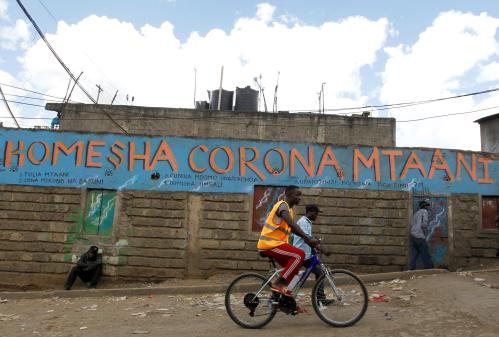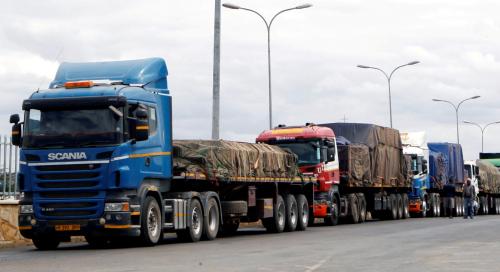Last month’s edition of the International Monetary Fund (IMF)’s biannual Regional Economic Outlook for Sub-Saharan Africa, which discusses economic developments and prospects for the region, pays special attention to the financial channels through which COVID-19 has—and will—impact the economic growth of the region. Notably, the authors of the report reduced their GDP growth estimates from their October 2019 forecast by 5.2 percentage points to -1.6 percent. The estimates for Nigeria and South Africa, the region’s largest economies, are even lower, at -3.4 and -5.8 percent respectively.
The report indicates that these contractions will largely be driven by three shocks: (1) supply chain disruptions and reduced demand, (2) the spillover effects of plummeting global growth, and (3) a decline in commodity prices. The shocks in their own right—and their knock-on effects—may hamper the ability of countries to finance their spending needs. Rising interest rates make it costly to borrow money in the short run, but the necessity of borrowing in the short run constricts countries’ ability to finance expenditure in the long run.
Figure 1 shows how the Emerging Market Bond Index (EMBI) for sub-Saharan Africa has changed following the onset of various financial slumps of the past decade. The COVID-19 pandemic has resulted in the sharpest upturn in the region’s cost of borrowing compared to the other events, including the global financial crisis of 2008. Since February 2020, the interest rates on sovereign debt more generally have risen by approximately 700 basis points.
Figure 1. COVID-19 has seen a sharper increase in the cost of borrowing (Emerging Market Bond Index) than any event in the last decade
 Source: International Monetary Fund, Regional Economic Outlook for Sub-Saharan Africa, April 2020
Source: International Monetary Fund, Regional Economic Outlook for Sub-Saharan Africa, April 2020
The report underscores an exigent need for additional financing to fund health expenditures and support vulnerable groups. For example, Nigeria and South Africa have packages worth 0.7 percent and 3 percent of their GDPs, respectively. Côte d’Ivoire, Namibia, and Senegal all have stimulus packages amounting to upwards of 4 percent of their respective GDPs, while Niger has announced a package exceeding 7 percent of its GDP.
Notably, the pandemic has not had a uniform effect on the cost of borrowing; For example, oil exporters have seen an even steeper increase in interest rates, after a drop in export prices left these countries with higher deficits than expected. The report projects that interest payments facing oil-exporting countries could approach 20 percent of revenue at some point this year (Figure 2). Importantly, these higher interest rates divert a greater share of revenue to interest payments for these countries rather than for productive domestic spending.
Figure 2. Oil exporters, compared to the rest of the region, are expected to devote a greater share of their revenues to interest payments
 Source: International Monetary Fund, Regional Economic Outlook for Sub-Saharan Africa, April 2020
Source: International Monetary Fund, Regional Economic Outlook for Sub-Saharan Africa, April 2020
The report recommends solutions that assume that investors view the pandemic and its various repercussions as temporary in nature. The authors believe that, following the crisis, the region will resume a growth path that safeguards debt sustainability. In the meantime, they recommend that countries do whatever it takes to prevent the spread of the virus and protect the most vulnerable people and firms, even in the absence of external financing from the international community. However, it also cautions that a dearth of external financing could turn issues of liquidity into issues of solvency. In other words, this one-off event could become a long-lived financial crisis.
For further discussion on ways the international community can help Africa finance the pandemic, see COVID-19 and debt standstill for Africa: The G-20’s action is an important first step that must be complemented, scaled up, and broadened and How to ensure Africa has the financial resources to address COVID-19.
The Brookings Institution is committed to quality, independence, and impact.
We are supported by a diverse array of funders. In line with our values and policies, each Brookings publication represents the sole views of its author(s).






Commentary
Figures of the week: The costs of financing Africa’s response to COVID-19
May 7, 2020